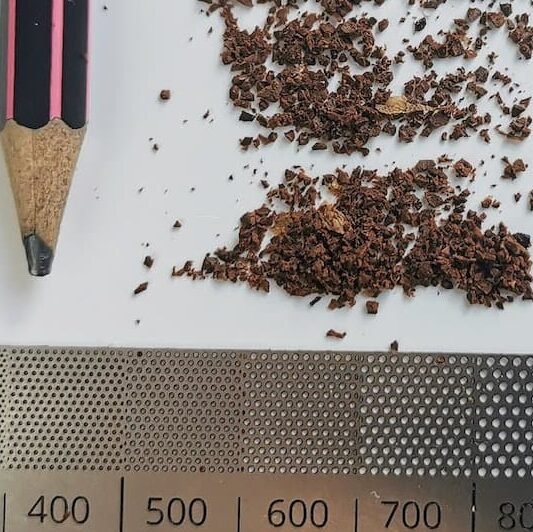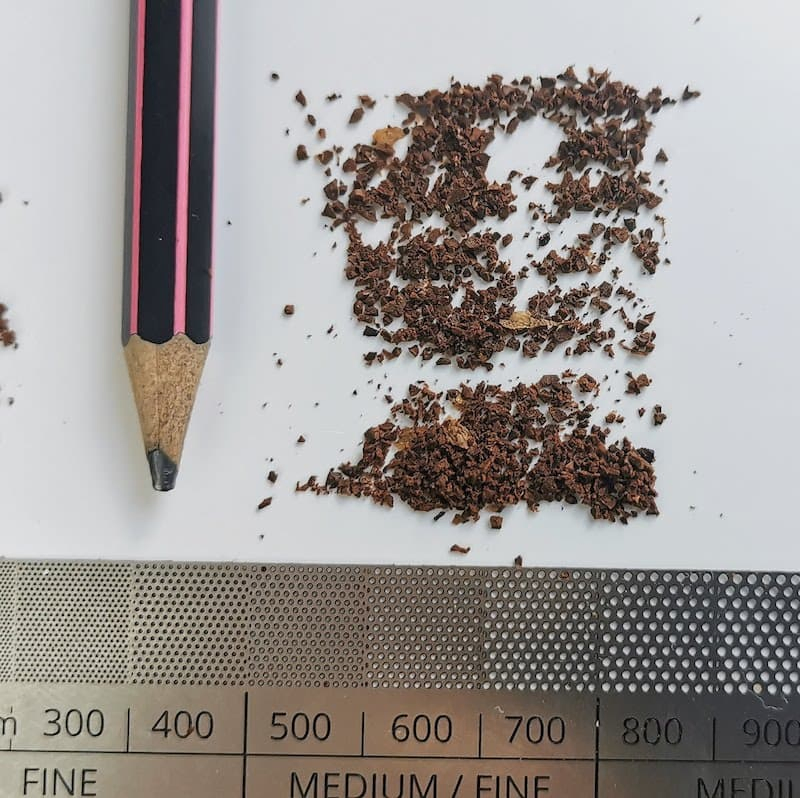grind size chart & Database
Grinding coffee beans is both simple and complicated at the same time. Here I have collected everything you need to know about grind size.
The below grounds are pictured next to the Kruve Brewler and a regular pencil. The numbers on the images refer to microns (ug).
If you’re really determined to be precise with your grind size, I’d encourage you to get a Brewler for yourself. It’s a cheap and elegant product.
Pour Over grind size (beginner)
- If you’re brewing big batches (>320 ml) with a multi-pour technique, it’s a good idea to grind slightly coarser than you’d think.
- ⚠️ Please note: This is especially the case if you have an entry-level conical grinder (ie. Baratza Encore or Hario Skerton) and are brewing larger batches at 1:15 ratio.
POUR OVER GRIND SIZE (ADVANCED)
- If you have a more “premium” grinder (flat burr/high-end conical), you should grind finer and use a longer ratio to capitalize on increased consistency.
- This is especially the case if you’re brewing light roasts
(btw: check out my post on extracting light roasts here)
How to grind coffee: Dialing in
Even though it’s handy to have some numbers that can give you a rough idea about grind size on a given grinder, it will never be definitive.
There are so many factors in play when it comes to grinding size. Grind size is just one variable in the equation that is extraction — that means that other factors will also come into play:
- Brew ratio
- Total brew time
- Agitation
- Water temperature, etc
Example: James Hoffmann’s V60 method’s grind size is a lot finer compared to Tetsu Kasuya’s 4:6 approach.
Grind size distribution & Fines
Other factors also come into play. Some grinders produce only a small percentage of fines in their total distribution, and as a result, you can grind finer without facing the same issues you would meet with a cheaper entry-level grinder.
A third thing to keep in mind is that certain coffee beans tend to grind differently. Some beans produce many fines (especially light roasted Ethiopians), which means you might have to grind a few steps coarser than you usually would.
If you brew espresso, you’ll also have to change grind size depending on the coffee’s age and how full of beans the hopper is.
So, in other words: Grind size is hugely complex. But don’t worry; with experience, you’ll get a feel for it and pay less attention to more simple metrics like clicks.
Grind size database (crowdsourced)
- This grinder database is crowdsourced – it’s based on feedback from the site’s readers.
- Please, submit your grinder here by following the link and help fellow coffee lovers. It should take less than 5 minutes to fill out the form.
- Measurement refers to the various grinder measurements that are used. Some grinders use ‘clicks,’ other uses an adjustment dial, while some manual grinders are best described with ‘rotations from zero’.
- ‘Year‘ is added, because models sometimes change. (For instance, the 2019 & 2020 version of the 1Zpresso Jx have a different adjustment dial).
- Please note: All these grind sizes are approximations — you will have to dial in the correct grind size by yourself.
Grinder models – click to see grind size recommendastions
- French Press: 48
- Pour Over: 44
- AeroPress: 40
- Moka Pot: 34
- Espresso: 24
- French Press: 75-90
- Pour Over: 60-75
- AeroPress: 48-60
- Moka Pot: 42-48
- Espresso: 30-36
-
This version has a red dot on the adjustment wheel
- French Press: 4-3
- Pour Over: 3-2.5
- AeroPress: 2.5
- Moka Pot: 2
- Espresso: 1.2-1.5
-
This version has a grey dot on the adjustment wheel
- French Press: 4.5
- Pour Over: 3.5
- AeroPress: 3
- Moka Pot: 2.5
- Espresso: 1.7-2
-
Uncoated burr version
- French Press: 8.0
- Pour Over: 6.5-7.5
- AeroPress: 5-6
- Moka Pot: 4-5
- Espresso: 3
- French Press: 7.5
- Pour Over: 5.5-7
- AeroPress: 4-6
- Moka Pot: 4-5
- Espresso: 2.6
- French Press: 7
- Pour Over: 5-6.5
- AeroPress: 4-6
- Moka Pot: 4-5
- Espresso: 2.2
-
Zero calibrated to the point where the handle can’t spin freely
- French Press: 4-5 (2nd rotation)
- Pour Over: 2-4 (2nd rotation)
- AeroPress: 0-2 (2nd rotation)
- Moka Pot: 5 (1st rotation)
- Espresso: 2.5-3 (1st rotation)
-
Pentagonal version 2021 (China market)
- French Press: 80
- Pour Over: 60-75
- AeroPress: 45
- Moka Pot: 40
- Espresso: 33
- French Press: 4-5
- Pour Over: 3-4
- AeroPress: 2-3.5
- Moka Pot: 2-3
- Espresso: n/a
- French Press: 20
- Pour Over: 12-18
- AeroPress: 9-12
- Moka Pot: 10-8
- Espresso: 8-6
- French Press: 50
- Pour Over: 45
- AeroPress: 20
- Moka Pot: 15
- Espresso: 1
- French Press: 30-34
- Pour Over: 20-32
- AeroPress: 14-24
- Moka Pot: 12-15
- Espresso: 9-12
- French Press: 50
- Pour Over: 35-45
- AeroPress: 25-35
- Moka Pot: 17-25
- Espresso: 8-19
- French Press: 55-65
- Pour Over: 40-55
- AeroPress: 25-40
- Moka Pot: 17-25
- Espresso: 5-17
-
RPM will affect grind size. Here’s a suggested range for various brewing methods.
- French Press (RPM 600-800): 60-70
- Pour Over (RPM 600-800): 45-65
- AeroPress (RPM 600-800): 30-45
- Moka Pot (RPM 1200-1500): 20-30
- Espresso (RPM 1200-1500): 10-20
- French Press: 75-85
- Pour Over: 50-75
- AeroPress: 35-50
- Moka Pot: 25-35
- Espresso: 10-25
- French Press: 5
- Pour Over: 1-4
- AeroPress: 1-3
- Moka Pot: 1
- Espresso: n/a
- French Press: 8
- Pour Over: 5
- AeroPress: 4
- Moka Pot: 3
- Espresso: n/a
- French Press: 25
- Pour Over: 19-23
- AeroPress: 15-17
- Moka Pot: 10-14
- Espresso: 5-7
- French Press: 3.2
- Pour Over: 3
- AeroPress: 2.5
- Moka Pot: 2
- Espresso: 1.5
- French Press: 3.5
- Pour Over: 3.0
- AeroPress: 2
- Moka Pot: 1.8
- Espresso: 0.9
- French Press: 2.5
- Pour Over: 2.3
- AeroPress: 2
- Moka Pot: 1.8
- Espresso: 1.5
- French Press: 2.7
- Pour Over: 2.3
- AeroPress: 2
- Moka Pot: 1.8
- Espresso: 1.5
- French Press: 55
- Pour Over: 40-50
- AeroPress: 24-40
- Moka Pot: 18-24
- Espresso: 9-24
- French Press: 55
- Pour Over: 38
- AeroPress: 30
- Moka Pot: 15
- Espresso: 5
- French Press: 20-25
- Pour Over: 15-20
- AeroPress: 10-17
- Moka Pot: 9-15
- Espresso: 8
- French Press: 16
- Pour Over: 13-15
- AeroPress: 11-15
- Moka Pot: 9-12
- Espresso: 7-9
- French Press: 24
- Pour Over: 20
- AeroPress: 15
- Moka Pot: 12
- Espresso: 8
- French Press: 24-26
- Pour Over: 16-18
- AeroPress: 10-12
- Moka Pot: 10
- Espresso: 8
- French Press: 19-23
- Pour Over: 15-19
- AeroPress: 11-15
- Moka Pot: 9-11
- Espresso: 5-7
- French Press: 10-12
- Pour Over: 8-11
- AeroPress: 6-8
- Moka Pot: 4-6
- Espresso: 1-3
- French Press: 11-14
- Pour Over: 5-10
- AeroPress: 4-6
- Moka Pot: 2-3
- Espresso: n/a
- French Press: 15
- Pour Over: 12
- AeroPress: 7-11
- Moka Pot: 6
- Espresso: n/a
- French Press: 13
- Pour Over: 10
- AeroPress: 8
- Moka Pot: 5
- Espresso: 3
- French Press: 13-16
- Pour Over: 11-14
- AeroPress: 7-9
- Moka Pot: 4-6
- Espresso: n/a
- French Press: 23
- Pour Over: 17-20
- AeroPress: 15
- Moka Pot: 10-13
- Espresso: 5-6
- French Press: 1.5-1.6
- Pour Over: 1.2-1.4
- AeroPress: 1.1
- Moka Pot: 8
- Espresso: 7





